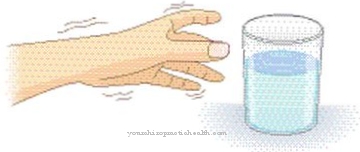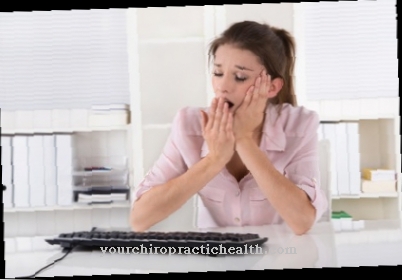Growing pains are not clearly defined and can vary in strength depending on the child. When the growth is complete, growing pains disappear on their own.
What are growing pains?

Growing pains can occur in children as they grow. The pain caused by growth is particularly evident in the limbs and is usually more pronounced during periods of rest (e.g. at night or in the evening) than when the child concerned is physically active.
The thighs and lower legs are particularly often affected by growing pains; in some cases the pain manifests itself in joints such as the knee joint. Typically, the growth-related pain in an affected child does not always appear in the same part of the body, but also migrates and changes the side of the body.
On average, up to 30% of children are affected by growing pains as they grow. The pain is probably slightly more common in girls than in boys.
causes
In medicine the exact causes are for occurring Growing pains largely unknown in children. However, it is believed that growing pains are, among other things, related to bone growth:
Scientific studies suggest that bone growth in children mainly takes place during periods of physical rest and that the symptoms are therefore particularly pronounced during these phases.
Further hypotheses suggest that growing pains in children can be favored by poor posture or circulatory disorders, for example. It is also possible that strong physical stress or a fundamentally increased fatigue in children have an influence on growing pains. However, these assumptions have not yet been conclusively confirmed.
Diseases with this symptom
- Circulatory disorders
- Posture damage
- Restless legs syndrome
Diagnosis & course
As it is with Growing pains If it is not a clearly defined clinical picture, it is correspondingly difficult to make a clear diagnosis by a treating doctor.
Often, growing pains are diagnosed as part of a so-called exclusion diagnosis; This means that a child affected by the corresponding pain is first examined for various other causes of symptoms in order to rule out the existence of these causes. So behind pain, which is also characteristic of growing pains, for example injuries or various infections can hide.
Rheumatic diseases or new tissue formation on the limbs can also lead to symptoms that resemble growing pains. If necessary, such diseases can be excluded with the help of blood tests or x-rays.
Growing pains can occur in children well into puberty. Typically, growing pains occur in phases and then subside automatically after a possible period of up to about an hour. Growing pains usually show a good prognosis and do not recur once the growth is complete.
Complications
Growing pains are not uncommon during puberty. Between the ages of 12 and 16, there may occasionally be moderate to severe pain in the bones. This pain can intensify after physical activity such as football or an intensive long-distance run. Growing pains are not a cause for concern.
They are a sign that healthy growth is taking place. As a mother or father, there is no need to worry about growing pains. If you want to help yourself, cooling can always help. It is important not to cool the affected areas for more than an hour. Excessive exercise should also not be practiced too often.
The muscles that are just beginning to grow can be stressed too much, which can lead to a ruptured muscle fiber. In most cases, the cause of growing pains is growth hormone. Even if there are pills nowadays to balance these hormones, one should not necessarily interfere with the natural growth process of one's own child.
In order for the bones to grow quickly and with less pain, a sufficient supply of calcium is necessary. These can be vegetable or animal sources of calcium. If the growing pains have not gone overnight and are still there for days, you should contact a pediatrician. In this case it could be something else.
When should you go to the doctor?
Growing pains in children can be a huge burden for parents because they see their child suffering - and fear that there could be something worse behind it. For your own reassurance, it is therefore not wrong to visit the pediatrician the first time you have suspected growing pains or to discuss the observation during the next upcoming examination. He can clarify whether it is really just growing pains and whether they are normal.
As a result, the parents are reassured and are also much better able to be reassuring to their children while they are still dealing with growing pains. However, even after such an examination, parents must always make sure that the symptoms appear like typical growing pains. They come late in the afternoon into the night, and cannot be felt in the morning until noon. Swelling or reddening of the skin has nothing to do with normal growing pains.
If such symptoms occur, it is best to see your pediatrician as soon as possible. Since affected children with growing pains have complaints so often, parents inadvertently sometimes overlook other health problems that are also causing pain - just with different symptoms. Even if there are deviations from the normal pain pattern, for example if the pain intensifies, the pediatrician will examine the affected child again.
Doctors & therapists in your area
Treatment & Therapy
Since the causes of Growing pains are largely unknown, no causal treatment of the symptoms is possible. However, acute pain phases can be alleviated with the help of various measures.
Which measures are used in each individual case depends above all on the severity of the growing pains. Targeted massaging of the painful part of the body can be effective against comparatively weak growing pains; St. John's wort oil, which is massaged into the skin, can have a supportive effect.
Warmth can also have a positive effect on growing pains. For example, affected parts of the body can be supplied with pain-relieving warmth using hot water bottles or warming blankets. Another possibility for heat treatment of growing pains is the use of a red light lamp, which can be used to direct warming infrared light onto painful parts of the body.
If a child suffers from very pronounced growing pains, it is also possible, in consultation with a treating doctor, to administer painkillers in acute cases. Experts emphasize the importance that the preparation and dose of a pain reliever drug are suitable for a child's organism. It is also usually not recommended to use pain reliever medication for a long period of time.
Outlook & forecast
Growing pains don't affect every child, but they can be intense when they occur. Since they arise as the child grows, they may occur until the child stops growing. However, they often stop earlier and are no longer a problem in their late teens.
Parents with affected children should be prepared to have problems falling and staying asleep at night as they grow. While everything is still fine in the morning and at noon, the first signs appear from the late afternoon that growing pains are an issue today. It is particularly uncomfortable when the little ones have gone to bed pain-free and wake up in pain at night. Unfortunately, growing pains occur precisely at these times, which is characteristic of them and says that it is not anything worse. Fortunately, growing pains do not interfere with the healthy development of children, even if they can cost them a few nights of sleep.
If sleep becomes a serious problem, because you can no longer sleep through the night and are therefore tired during the day and cannot cope with everyday life, a doctor should be consulted. Otherwise, the growing pains become a hindrance to the school and social life of the children.
prevention
Because the factors that lead to Growing pains lead, are not yet known in medicine, it is usually not possible to prevent the symptoms. Medical advice from parents of affected children can, however, point to individual pain-relieving treatment methods. In this way, early measures for acute growing pains can counteract an increase in pain.
You can do that yourself
A number of home remedies and measures can help with growing pains. In particular, protection and warmth have proven effective. A hot bath alleviates the symptoms, as does a gentle leg massage with arnica ointment, chamomile, sage or St. John's wort oil. Stretching exercises also help.
In particular, the thigh and calf muscles should be regularly loosened and stretched during acute pain attacks, because this stimulates blood circulation and accelerates muscle growth. Homeopathic remedies can also help with growing pains. Globuli Guaiacum D6, for example, is effective and should be taken before going to sleep for the best effect. In addition, parents should make sure that the child is eating a balanced and healthy diet. Dietary supplements with calcium, magnesium and vitamins C and D can compensate for any deficiencies and quickly relieve pain.
In severe cases, mild pain relievers may be prescribed to give the child a good night's sleep. However, distraction is most effective for growing pains. When playing or cuddling, the pain is usually quickly forgotten and disappears by itself after a few minutes. To be on the safe side, severe growing pains should be discussed with the treating pediatrician.



.jpg)









.jpg)

.jpg)
.jpg)











.jpg)